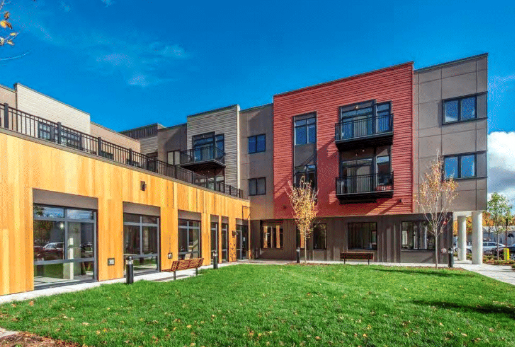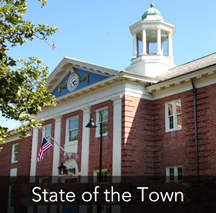Should Lincoln try to ease the burden on taxpayers with a shift in property tax policy, and/or encouraging more commercial and housing development in South Lincoln? Residents got a chance at last weeks’ State of the Town meeting to discuss both ideas, and will likely have a chance to vote on then in the spring.
In the wake of the big tax increase resulting from the school project, the Property Tax Committee has been studying two ideas to help reduce the strain for some Lincoln homeowners: a local version of the existing state circuit-breaker program, and a residential tax exemption. Both ideas were also discussed at a public forum last month.
A circuit-breaker program would limit the percentage of income a homeowner would have to pay in property taxes based on their income, assets, length of time in town (10+ years), and age (65+). Funding would come from a small across-the-board tax rate increase. A residential tax exemption would exempt a certain percentage of the value of everyone’s property, meaning that the tax burden would shift toward those with higher-valued homes to benefit those with homes at the lower end of the range.
Under the local circuit-breaker scenario, “everyone pays a little bit more in order to provide significant benefits to those with identified need,” Selectman Jennifer Glass said at the November 2 town-wide meeting. Homeowners in Sudbury, which has a program like this, have seen an average increase of about $73 a year as a result, she added.
Glass acknowledged that some residents are unhappy with the idea of another tax hike for some property owners so soon after the big increase, seeing it as a “bait and switch” move. The median tax bill in fiscal 2020 rose by 12.7% and with the tax rate went up from $14.03 to $15.36 per $1,000 of assessed property. Of that new total, $1.95 is earmarked for the school project, she said.
Neither idea will be implemented without a town-wide vote; “it’s too big a policy decision to make without consulting the town,” Glass said, urging residents to fill out a short survey to express their opinions.
Residents at the October 15 forum were open to the circuit-breaker idea but mostly negative about a residential tax exemption. Sentiment was much the same for the few residents who spoke last Saturday.
“A residential exemption would have been a great discussion three years ago and might have factored into the decision-making process” about the school, former Finance Committee member Peyton Marshall said. “Now we’re encountering buyer’s remorse [when] people who didn’t show up in December opened their tax bill.” As a result, the town is in a “period of disequilibrium” when some are thinking of selling their homes either soon, or after the school project is finished.
“We should consider all this in three to five years after people have made their housing decisions… It’s really explosive” to discuss it now, Marshall said.
South Lincoln zoning
In an effort to make Lincoln more attractive to residents and businesses and perhaps boost the tax base, rezoning part of South Lincoln around the commuter rail station was also discussed at an earlier public forum.
At the State of the Town meeting, Planning Board members presented the proposal to replace the B-1 and B-2 districts in South Lincoln and create a new South Lincoln Village District zone with two subareas: Village Business and Village Residential (VB and VR). Handouts included a draft of bylaw language (created with the help of the Metropolitan Area Planning Council) that will be up for a vote at the Annual Town Meeting in March 2020.
In both subareas, the proposal would allow (by special permit) multifamily housing, with a “density bonus” in return for amenities and affordable housing. It would also expand the parameters of projects that would be allowed by right, and would set out design guidelines for the Planning Board to apply when evaluating projects. Mixed-use buildings could be up to 2.5 floors high along Lincoln Road, with residential structures up to three floors father back from the road.

This development in West Concord was cited by Lincoln officials as an example of a good mixed-use village project.
A recently completed mixed-use project in West Concord is “something on the order of what we want to see,” Taylor said. That project includes 74 housing units and 36,000 square feet of commercial space, and is located very close to the commuter rail station, village center, and rail trails.
The rezoning proposals come from a subcommittee of the South Lincoln Planning and Implementation Committee. As detailed in this presentation by Planning Board chair Margaret Olson, SLPIC’s goals include promoting the area as a vibrant public gathering place; encouraging business and professional services; offering a broader range of housing options; and supporting more sustainable transportation through MBTA station improvements, better parking, and regional shuttle services.
Former board member Robert Domnitz worried that the changes won’t get Town Meeting approval if residents didn’t retain veto power over individual projects. However, the current path for getting town go-ahead is “a very cumbersome process that makes development a lot harder,” said board member Gary Taylor.
“It’s clear what we’re asking you to do is place some confidence in the Planning Board. It’s a more streamlined process and that’s intentional,” Taylor said. “It’s very difficult to shape projects on the floor of Town Meeting.”
One of the goals is to make South Lincoln more attractive as a place to shop for Lincoln residents and others who already drive through town without stopping, while also encouraging everyone to use the commuter rail and underground parking. However, some residents said there will be more cars and traffic in the area if more housing is available, regardless of whether the commuter rail is more heavily used.
“We’re not lowering traffic in the sense of absolute numbers, but there will be less traffic impact going forward than there would be otherwise,” Taylor responded.
Resident Sarah Mattes urged officials to expand and publicize the commuter parking that’s already available before considering “drastic zoning changes.” Others questioned where there was real demand for more commercial and transportation services in South Lincoln from residents who already live there.

